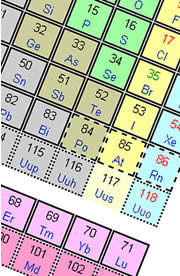International Team Discovers Element 117
A new chemical element has been added to the Periodic Table: A paper on the discovery of element 117 has been accepted for publication in Physical Review Letters.

Oak Ridge National Laboratory is part of a team that includes the Joint Institute of Nuclear Research (Dubna, Russia), the Research Institute for Advanced Reactors (Dimitrovgrad), Lawrence Livermore National Laboratory, Vanderbilt University and the University of Nevada Las Vegas. ORNL’s role included production of the berkelium-249 isotope necessary for the target, which was subjected to an extended, months-long run at the heavy ion accelerator facility at Dubna, Russia.
“Without the berkelium target, there could have been no experiment,” says ORNL Director of Strategic Capabilities Jim Roberto, who is a principal author on the PRL paper and who helped initiate the experiment. The berkelium was produced at the High Flux Isotope Reactor and processed at the adjoining Radiochemical Engineering & Development Laboratory as part of the most recent campaign to produce californium-252, a radioisotope widely used in industry and medicine.
“Russia had proposed this experiment in 2004, but since we had no californium production at the time, we couldn’t supply the berkelium. With the initiation of californium production in 2008, we were able to implement a collaboration,” Roberto says.
Professor Joe Hamilton of Vanderbilt University (who helped establish the Joint Institute for Heavy Ion Research at ORNL) introduced Roberto to Yuri Oganessian of Russia’s JINR. Five months of the Dubna JINR U400 accelerator’s calcium-48 beam–one of the world’s most powerful–was dedicated to the project.
 The massive effort identified a total of six atoms of element 117 and the critical reams of data that substantiate their existence.
The massive effort identified a total of six atoms of element 117 and the critical reams of data that substantiate their existence.
The two-year experimental campaign began with a 250-day irradiation in HFIR, producing 22 milligrams of berkelium-249, which has a 320-day half-life. The irradiation was followed by 90 days of processing at REDC to separate and purify the berkelium. The Bk-249 target was prepared at Dimitrovgrad and then bombarded for 150 days at the Dubna facility. Lawrence Livermore, which now has been involved in the discovery of six elements with Dubna (113, 114, 115, 116, 117, and 118), contributed data analysis, and the entire team was involved in the assessment of the results.
This is the second element that ORNL has had a role in discovering, joining element 61, promethium, which was discovered at the Graphite Reactor during the Manhattan project and reported in 1946. ORNL, by way of its production of radioisotopes for research, has contributed to the discovery of a total of seven new elements.
Members of the ORNL team include the Physics Division’s Krzysztof Rykaczewsi, Porter Bailey of the Nonreactor Nuclear Facilities Division, and Dennis Benker, Julie Ezold, Curtis Porter and Frank Riley of the Nuclear S&T Division. Roberto says the success of the element-117 campaign underscores the value of international collaborations in science. “This use of ORNL isotopes and Russian accelerators is a tremendous example of the value of working together,” he says. “The 117 experiment paired one of the world’s leading research reactors–capable of producing the berkelium target material–with the exceptional heavy ion accelerator and detection capabilities at Dubna.”
Islands of Stability
Roberto also says the experiment, in addition to discovering a new chemical element, has pushed the Periodic Table further into the neutron-rich regime for heaviest elements. “New isotopes observed in these experiments continue a trend toward higher lifetimes for increased neutron numbers, providing evidence for the proposed “island of stability” for super-heavy nuclei,” he says. “Because the half-lives are getting longer, there is potential to study the chemistry of these nuclei,” Roberto says. “These experiments and discoveries essentially open new frontiers of chemistry.”
Source: Webelements

